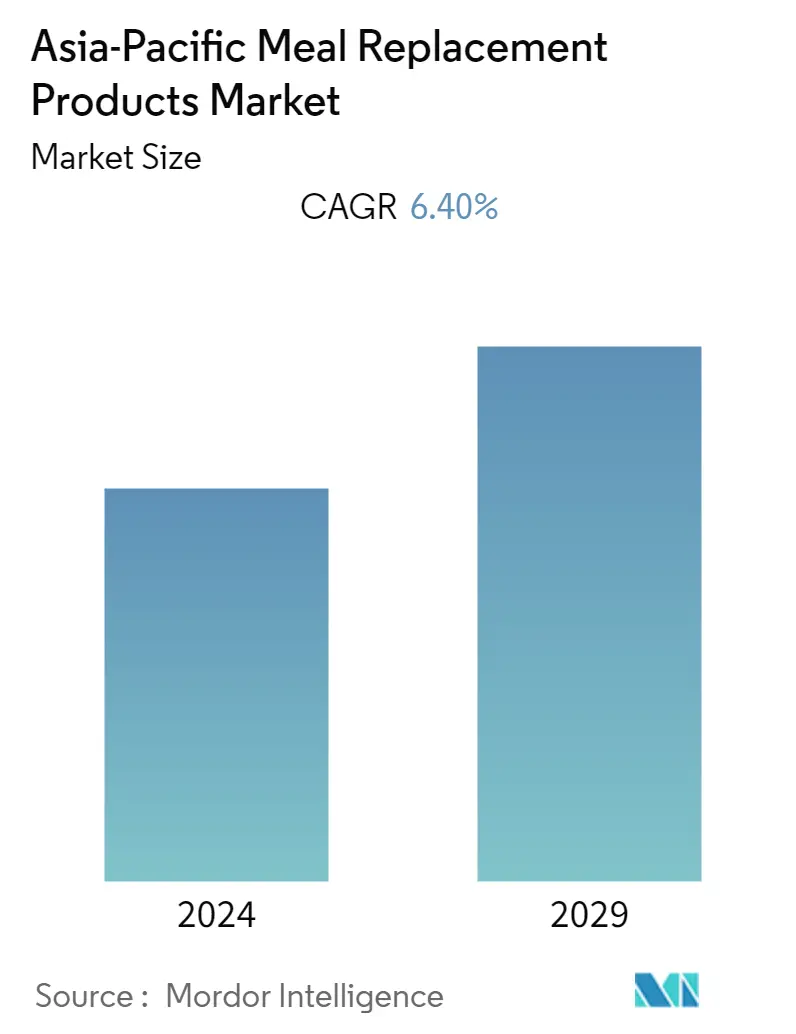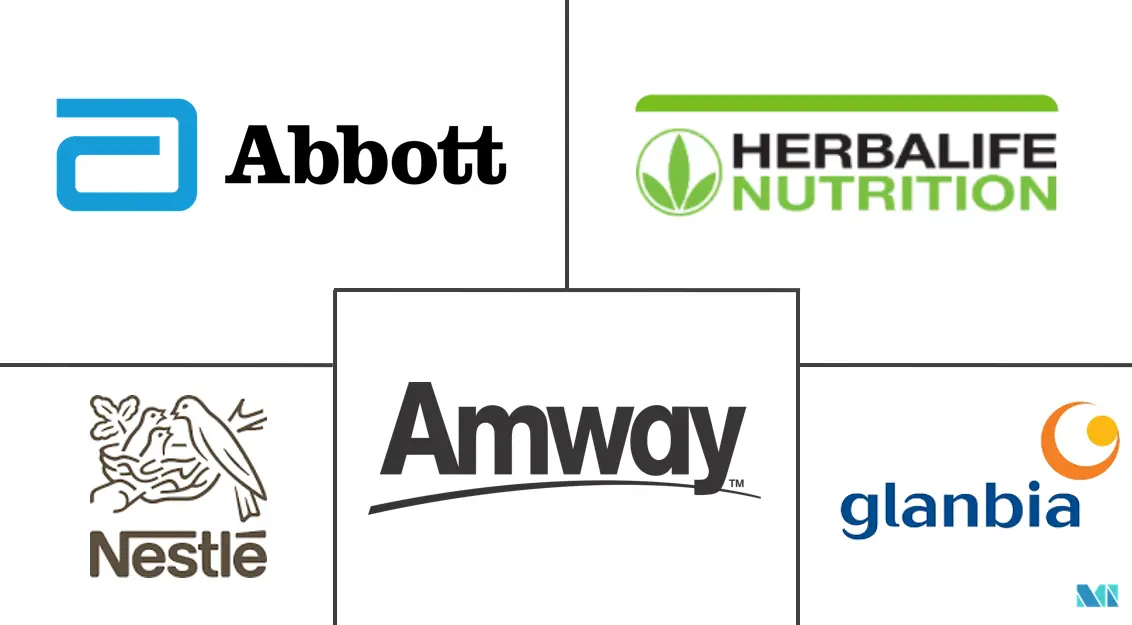Market Size of Asia-Pacific Meal Replacement Products Industry

| Study Period | 2019 - 2029 |
| Base Year For Estimation | 2023 |
| Forecast Data Period | 2024 - 2029 |
| Historical Data Period | 2019 - 2022 |
| CAGR | 6.40 % |
| Market Concentration | Low |
Major Players
*Disclaimer: Major Players sorted in no particular order |
APAC Meal Replacement Market Analysis
The Asia-Pacific meal replacement products market size is expected to grow from USD 3,731.26 million in 2023 to USD 5,088.20 million by 2028 at a CAGR of 6.40% during the forecast period.
- Meal replacement products are gaining traction among consumers who are monitoring their diet patterns, especially those who are managing their weight or controlling their blood sugar levels. Additionally, the market mainly targets consumers with time constraints, busy lifestyles, and hectic work schedules by helping them replace their meals with healthier and nutritious products instead of conventional snacks.
- Asia-Pacific has one of the world's highest obesity rates. In India, the percentage of overweight or obese women grew from 20.6% in 2016 to 24% in 2021, according to the National Family Health Survey (NFHS). The prevalence among men, on the other hand, rose by nearly 22.9% in 2021. Such factors are expected to drive the region's demand for meal replacement products.
- The industry caters to consumers with time restrictions, demanding schedules, and busy lifestyles by assisting them in switching from standard snacks to healthy meals. On the contrary, a large proportion of the population is health and fitness conscious, which is expected to boost the demand. The weight management trend has boosted the demand for meal replacement bars and powders in the food industry, making Australia the largest market for meal replacement products in the Asia-Pacific region.
- However, due to factors such as high prices and less sustainability speculated for long-term consumption of meal replacement products, the market faces constraints in expanding its consumer base. Products like supplement powders and shakes are generally consumed by those who are willing to spend exponentially high to satiate their hunger.
APAC Meal Replacement Industry Segmentation
Meal replacement products are formulated to provide the nutrition of a full meal. Most meal replacement supplements contain 200-400 calories, have high fiber content, are low in carbohydrates, and are enriched with the goodness of vitamins and minerals.
The Asia-Pacific meal replacement products market is segmented by product type, distribution channel, and geography. By product type, the market studied is segmented into ready-to-drink products, nutritional bars, powdered supplements, and other product types. Based on the distribution channel, the market is segmented into supermarkets/hypermarkets, online retail stores, convenience stores, specialty stores, and other distribution channels. The report analyzes the market for meal replacement products in established and emerging countries of Asia-Pacific, including China, Japan, India, Australia, and the Rest of Asia-Pacific.
For each segment, the market sizing and forecasts have been done on the basis of value (in USD million).
| Product Type | |
| Ready-to-Drink Products | |
| Nutritional Bars | |
| Powdered Supplements | |
| Other Product Types |
| Distribution Channel | |
| Supermarkets/Hypermarkets | |
| Convenience Stores | |
| Specialty Stores | |
| Online Retail Stores | |
| Other Distribution Channels |
| Geography | |
| China | |
| Japan | |
| India | |
| Australia | |
| Rest of Asia-Pacific |
Asia-Pacific Meal Replacement Products Market Size Summary
The Asia-Pacific meal replacement market is experiencing significant growth, driven by increasing consumer awareness of health and wellness. This market is characterized by a rising demand for products that cater to individuals with busy lifestyles who seek convenient and nutritious alternatives to traditional meals. The prevalence of obesity and diabetes in the region has prompted consumers to monitor their diets more closely, leading to a surge in the popularity of meal replacement products such as bars and powders. Companies like General Mills, KETO, and Abbott Laboratories are capitalizing on this trend by offering products tailored to specific dietary needs, including no-sugar and keto options. The health and wellness trend continues to be a major influence, with organic meal replacement products gaining traction among health-conscious consumers.
The market is further bolstered by the increasing demand for on-the-go nutrition solutions, such as cereal bars and shakes, which provide a convenient way to maintain energy and nutritional intake. The rise of specialty and online retail stores has made these products more accessible, contributing to their growing popularity. Key players in the market, including Herbalife, Amway Corp., and Nestle SA, are investing in product innovation and expanding their distribution channels to enhance visibility and cater to diverse consumer preferences. The introduction of new functionalities and taste preferences aims to attract various age groups and maintain a competitive edge. As the market continues to evolve, the focus on emerging segments like sugar-free and vegan products presents new opportunities for growth.
Asia-Pacific Meal Replacement Products Market Size - Table of Contents
-
1. MARKET DYNAMICS
-
1.1 Market Drivers
-
1.1.1 Consumers Managing Special Diets Strive on Meal Replacements
-
1.1.2 Rising Demand for Convenient and Small-Portion Meal
-
-
1.2 Market Restraints
-
1.2.1 Highly Priced Meal Replacement Products to Hamper Market Growth
-
-
1.3 Porter's Five Forces Analysis
-
1.3.1 Threat of New Entrants
-
1.3.2 Bargaining Power of Buyers/Consumers
-
1.3.3 Bargaining Power of Suppliers
-
1.3.4 Threat of Substitute Products
-
1.3.5 Intensity of Competitive Rivalry
-
-
-
2. MARKET SEGMENTATION
-
2.1 Product Type
-
2.1.1 Ready-to-Drink Products
-
2.1.2 Nutritional Bars
-
2.1.3 Powdered Supplements
-
2.1.4 Other Product Types
-
-
2.2 Distribution Channel
-
2.2.1 Supermarkets/Hypermarkets
-
2.2.2 Convenience Stores
-
2.2.3 Specialty Stores
-
2.2.4 Online Retail Stores
-
2.2.5 Other Distribution Channels
-
-
2.3 Geography
-
2.3.1 China
-
2.3.2 Japan
-
2.3.3 India
-
2.3.4 Australia
-
2.3.5 Rest of Asia-Pacific
-
-
Asia-Pacific Meal Replacement Products Market Size FAQs
What is the current Asia-Pacific Meal Replacement Products Market size?
The Asia-Pacific Meal Replacement Products Market is projected to register a CAGR of 6.40% during the forecast period (2024-2029)
Who are the key players in Asia-Pacific Meal Replacement Products Market?
Herballife Nutrition, Glanbia PLC, Nestle SA, Abbott Laboratories and Amway Corp are the major companies operating in the Asia-Pacific Meal Replacement Products Market.

